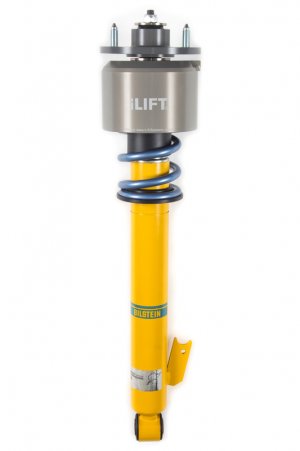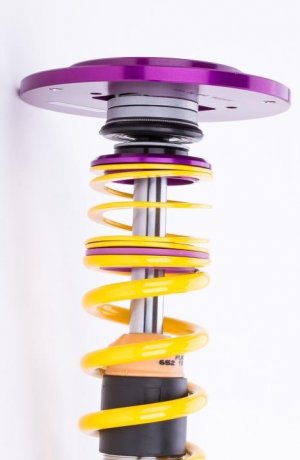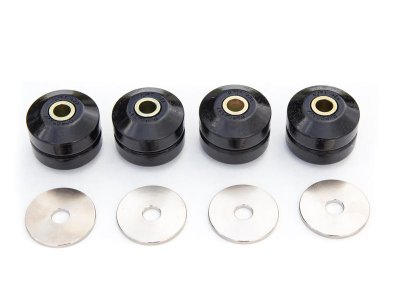Apologies for the dreary subject, but I wanted to share my experience in case anyone else finds themselves with this issue. I am also seeking advice.
I purchased a new set of KWV3's last year as they have plentiful accolades from respectable resources. I had my suspension/wheel/tire/break specialist in Fremont, CA, install them for me followed by an alignment. He mentioned as he was wrapping up, to check my "eccentric bolt shaft". I drove home and the car seemed ok, but the next time I drove the car (a few days later) I noticed a 'pogo stick' like squeak, which was pretty awful. I didn't notice it before as I didn't notice it on the highway, but on town roads it's unbearable. I contacted my installer, and he suggested I spray some WD40 into places he did not describe. He did invite me to return, but as his shop is a 2 hour drive for me I did not go back immediately as the car is a monthly weekend warrior and I figured it could wait. Fast forward a few months after not driving the car for a while and a noticeable temperature drop (December 2015) I noticed an audible "clunk" sound from the right rear as I turned right at low speeds. I also noticed a mild vibration from the steering wheel at highway speeds. I suspected my cv boot could have been on its way out, but I wasn't sure. One week later, I drove the car again, this time I accelerated onto the freeway, and the rear of the car began to sway aggressively in a circular motion, and the car instantly felt like it was going to spin out of control. This freaked me out enough that I slowed way down and drove the remainder of the short drive home under 30mph. After reading up on prime, I checked my wheel hubs and axle bolt, and didn't discover any issues.
I had her towed to my normal NSX mechanic in Daly city, and he diagnosed the rear instability to an eccentric bolt that was attached upside down, became stripped, and popped off. The rear right wheel lost its alignment, hence the scary instability. He also said the entire cars alignment was way off. He put on a new bolt with deeper threads, realigned my car, and it seems ok for the moment.
He also said that the squeaking was attributed to "smaller" rubber bushings that did not fit the factory top hats. I thought the KWV3's could be used with the factory top hats and bushings, unless I'm missing something, but he said that the coilovers were also a smaller diameter than oem, and wasn't sure if they could work with factory bushings.
My questions at the moment are:
- Should I contact my suspension installer and see if he's willing to compensate me for the diagnostic fee and repair of the upside down bolt that appears to be his error? I didn't tow the car to Fremont as he's 2 hours away and I would have had to figure out how to get back home, that and I trust my normal mechanic. (I figured it could have been much worse had it broken suddenly while I was accelerating around a corner)
- What should I do about the horrible pogo stick squeaking of the smaller bushings? Are the factory bushings in fact reusable with the KW's, and if so, should I ask my suspension mechanic to reinstall the system with the factory bushings that he probably threw away, and mucked up to begin with?
Thanks to any in advance.
I purchased a new set of KWV3's last year as they have plentiful accolades from respectable resources. I had my suspension/wheel/tire/break specialist in Fremont, CA, install them for me followed by an alignment. He mentioned as he was wrapping up, to check my "eccentric bolt shaft". I drove home and the car seemed ok, but the next time I drove the car (a few days later) I noticed a 'pogo stick' like squeak, which was pretty awful. I didn't notice it before as I didn't notice it on the highway, but on town roads it's unbearable. I contacted my installer, and he suggested I spray some WD40 into places he did not describe. He did invite me to return, but as his shop is a 2 hour drive for me I did not go back immediately as the car is a monthly weekend warrior and I figured it could wait. Fast forward a few months after not driving the car for a while and a noticeable temperature drop (December 2015) I noticed an audible "clunk" sound from the right rear as I turned right at low speeds. I also noticed a mild vibration from the steering wheel at highway speeds. I suspected my cv boot could have been on its way out, but I wasn't sure. One week later, I drove the car again, this time I accelerated onto the freeway, and the rear of the car began to sway aggressively in a circular motion, and the car instantly felt like it was going to spin out of control. This freaked me out enough that I slowed way down and drove the remainder of the short drive home under 30mph. After reading up on prime, I checked my wheel hubs and axle bolt, and didn't discover any issues.
I had her towed to my normal NSX mechanic in Daly city, and he diagnosed the rear instability to an eccentric bolt that was attached upside down, became stripped, and popped off. The rear right wheel lost its alignment, hence the scary instability. He also said the entire cars alignment was way off. He put on a new bolt with deeper threads, realigned my car, and it seems ok for the moment.
He also said that the squeaking was attributed to "smaller" rubber bushings that did not fit the factory top hats. I thought the KWV3's could be used with the factory top hats and bushings, unless I'm missing something, but he said that the coilovers were also a smaller diameter than oem, and wasn't sure if they could work with factory bushings.
My questions at the moment are:
- Should I contact my suspension installer and see if he's willing to compensate me for the diagnostic fee and repair of the upside down bolt that appears to be his error? I didn't tow the car to Fremont as he's 2 hours away and I would have had to figure out how to get back home, that and I trust my normal mechanic. (I figured it could have been much worse had it broken suddenly while I was accelerating around a corner)
- What should I do about the horrible pogo stick squeaking of the smaller bushings? Are the factory bushings in fact reusable with the KW's, and if so, should I ask my suspension mechanic to reinstall the system with the factory bushings that he probably threw away, and mucked up to begin with?
Thanks to any in advance.
Last edited:








